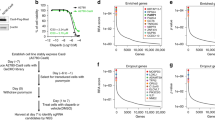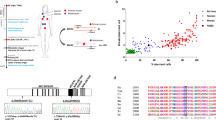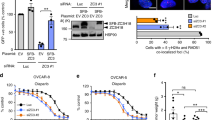Abstract
Ovarian tumor cells are often genomically unstable and hypersensitive to cisplatin. To understand the molecular basis for this phenotype, we examined the integrity of the Fanconi anemia–BRCA (FANC-BRCA) pathway in those cells. This pathway regulates cisplatin sensitivity and is governed by the coordinate activity of six genes associated with Fanconi anemia (FANCA, FANCC, FANCD2, FANCE, FANCF and FANCG) as well as BRCA1 and BRCA2 (FANCD1). Here we show that the FANC-BRCA pathway is disrupted in a subset of ovarian tumor lines. Mono-ubiquitination of FANCD2, a measure of the function of this pathway, and cisplatin resistance were restored by functional complementation with FANCF, a gene that is upstream in this pathway. FANCF inactivation in ovarian tumors resulted from methylation of its CpG island, and acquired cisplatin resistance correlated with demethylation of FANCF. We propose a model for ovarian tumor progression in which the initial methylation of FANCF is followed by FANCF demethylation and ultimately results in cisplatin resistance.
This is a preview of subscription content, access via your institution
Access options
Subscribe to this journal
Receive 12 print issues and online access
$209.00 per year
only $17.42 per issue
Buy this article
- Purchase on Springer Link
- Instant access to full article PDF
Prices may be subject to local taxes which are calculated during checkout





Similar content being viewed by others
References
Landis, S.H. et al. Cancer statistics, 1999. CA Cancer J. Clin. 49, 8–31 (1999).
Orth, K. et al. Genetic instability in human ovarian cancer cell lines. Proc. Natl. Acad. Sci. USA 91, 9495–9499 (1994).
Auersperg, N., Edelson, M.I., Mok, S.C., Johnson, S.W. & Hamilton, T.C. The biology of ovarian cancer. Semin. Oncol. 25, 281–304 (1998).
Harper, P., Marsh, D. & Zori, R. Current clinical practices for ovarian cancers. Semin. Oncol. 29, 3–6 (2002).
Husain, A. et al. Lisofylline sensitizes p53 mutant human ovarian carcinoma cells to the cytotoxic effects of cis-diamminedichloroplatinum (II). Gynecol. Oncol. 70, 17–22 (1998).
Joenje, H. & Patel, K.J. The emerging genetic and molecular basis of Fanconi anaemia. Nat. Rev. Genet. 2, 446–457 (2001).
Taniguchi, T. & D'Andrea, A.D. The Fanconi anemia protein, FANCE, promotes the nuclear accumulation of FANCC. Blood 100, 2457–2462 (2002).
Pace, P. et al. FANCE: the link between Fanconi anaemia complex assembly and activity. EMBO J. 21, 3414–3423 (2002).
Medhurst, A.L., Huber, P.A., Waisfisz, Q., de Winter, J.P. & Mathew, C.G. Direct interactions of the five known Fanconi anaemia proteins suggest a common functional pathway. Hum. Mol. Genet. 10, 423–429 (2001).
Garcia-Higuera, I. et al. Interaction of the Fanconi anemia proteins and BRCA1 in a common pathway. Mol. Cell 7, 249–262 (2001).
Taniguchi, T. et al. Convergence of the Fanconi anemia and ataxia telangiectasia signaling pathways. Cell 109, 459–472 (2002).
Howlett, N.G. et al. Biallelic inactivation of BRCA2 in Fanconi anemia. Science 297, 606–609 (2002).
Shimamura, A. et al. A novel diagnostic screen for defects in the Fanconi anemia pathway. Blood 100, 4649–4654 (2002).
de Winter, J.P. et al. The Fanconi anaemia gene FANCF encodes a novel protein with homology to ROM. Nat. Genet. 24, 15–16 (2000).
Esteller, M. CpG island hypermethylation and tumor suppressor genes: a booming present, a brighter future. Oncogene 21, 5427–5440 (2002).
Jones, P.A. & Laird, P.W. Cancer epigenetics comes of age. Nat. Genet. 21, 163–167 (1999).
Andrews, P.A. & Albright, K.D. Mitochondrial defects in cis-diamminedichloroplatinum(II)-resistant human ovarian carcinoma cells. Cancer Res. 52, 1895–1901 (1992).
Krop, I.E. et al. HIN-1, a putative cytokine highly expressed in normal but not cancerous mammary epithelial cells. Proc. Natl. Acad. Sci. USA 98, 9796–9801 (2001).
Provencher, D.M. et al. Characterization of four novel epithelial ovarian cancer cell lines. In Vitro Cell. Dev. Biol. Anim. 36, 357–361 (2000).
Wilson, A.P. Characterization of a cell line derived from the ascites of a patient with papillary serous cystadenocarcinoma of the ovary. J. Natl. Cancer Inst. 72, 513–521 (1984).
Rahman, N. & Stratton, M.R. The genetics of breast cancer susceptibility. Annu. Rev. Genet. 32, 95–121 (1998).
Esteller, M. et al. Promoter hypermethylation and BRCA1 inactivation in sporadic breast and ovarian tumors. J. Natl. Cancer Inst. 92, 564–569 (2000).
Hedenfalk, I. et al. Gene-expression profiles in hereditary breast cancer. N. Engl. J. Med. 344, 539–548 (2001).
Geisler, J.P., Hatterman-Zogg, M.A., Rathe, J.A. & Buller, R.E. Frequency of BRCA1 dysfunction in ovarian cancer. J. Natl. Cancer Inst. 94, 61–67 (2002).
Hilton, J.L. et al. Inactivation of BRCA1 and BRCA2 in ovarian cancer. J. Natl. Cancer Inst. 94, 1396–1406 (2002).
Brown, R. et al. hMLH1 expression and cellular responses of ovarian tumour cells to treatment with cytotoxic anticancer agents. Oncogene 15, 45–52 (1997).
Strathdee, G., MacKean, M.J., Illand, M. & Brown, R. A role for methylation of the hMLH1 promoter in loss of hMLH1 expression and drug resistance in ovarian cancer. Oncogene 18, 2335–2341 (1999).
Plumb, J.A., Strathdee, G., Sludden, J., Kaye, S.B. & Brown, R. Reversal of drug resistance in human tumor xenografts by 2′-deoxy-5-azacytidine-induced demethylation of the hMLH1 gene promoter. Cancer Res. 60, 6039–6044 (2000).
Fogh, J., Wright, W.C. & Loveless, J.D. Absence of HeLa cell contamination in 169 cell lines derived from human tumors. J. Natl. Cancer Inst. 58, 209–214 (1977).
Hamilton, T.C. et al. Characterization of a human ovarian carcinoma cell line (NIH:OVCAR-3) with androgen and estrogen receptors. Cancer Res. 43, 5379–5389 (1983).
Hills, C.A. et al. Biological properties of ten human ovarian carcinoma cell lines: calibration in vitro against four platinum complexes. Br. J. Cancer 59, 527–534 (1989).
Rauh-Adelmann, C. et al. Altered expression of BRCA1, BRCA2, and a newly identified BRCA2 exon 12 deletion variant in malignant human ovarian, prostate, and breast cancer cell lines. Mol. Carcinog. 28, 236–246 (2000).
Kiguchi, K. et al. Selection of human ovarian carcinoma cells with high dissemination potential by repeated passage of the cells in vivo into nude mice, and involvement of Le(x)-determinant in the dissemination potential. Jpn. J. Cancer Res. 89, 923–932 (1998).
Schilder, R.J. et al. Metallothionein gene expression and resistance to cisplatin in human ovarian cancer. Int. J. Cancer 45, 416–422 (1990).
Lewis, A.D., Hayes, J.D. & Wolf, C.R. Glutathione and glutathione-dependent enzymes in ovarian adenocarcinoma cell lines derived from a patient before and after the onset of drug resistance: intrinsic differences and cell cycle effects. Carcinogenesis 9, 1283–1287 (1988).
Kupfer, G.M., Naf, D., Suliman, A., Pulsipher, M. & D'Andrea, A.D. The Fanconi anaemia proteins, FAA and FAC, interact to form a nuclear complex. Nat. Genet. 17, 487–490 (1997).
Yamashita, T., Barber, D.L., Zhu, Y., Wu, N. & D'Andrea, A.D. The Fanconi anemia polypeptide FACC is localized to the cytoplasm. Proc. Natl. Acad. Sci. USA 91, 6712–6716 (1994).
Timmers, C. et al. Positional cloning of a novel Fanconi anemia gene, FANCD2. Mol. Cell 7, 241–248 (2001).
Siddique, M.A., Nakanishi, K., Taniguchi, T., Grompe, M. & D'Andrea, A.D. Function of the Fanconi anemia pathway in Fanconi anemia complementation group F and D1 cells. Exp. Hematol. 29, 1448–1455 (2001).
Garcia-Higuera, I., Kuang, Y., Naf, D., Wasik, J. & D'Andrea, A.D. Fanconi anemia proteins FANCA, FANCC, and FANCG/XRCC9 interact in a functional nuclear complex. Mol. Cell. Biol. 19, 4866–4873 (1999).
Ory, D.S., Neugeboren, B.A. & Mulligan, R.C. A stable human-derived packaging cell line for production of high titer retrovirus/vesicular stomatitis virus G pseudotypes. Proc. Natl. Acad. Sci. USA 93, 11400–11406 (1996).
Kuang, Y. et al. Carboxy terminal region of the Fanconi anemia protein, FANCG/XRCC9, is required for functional activity. Blood 96, 1625–1632 (2000).
Naf, D., Kupfer, G.M., Suliman, A., Lambert, K. & D'Andrea, A.D. Functional activity of the Fanconi anemia protein FAA requires FAC binding and nuclear localization. Mol. Cell. Biol. 18, 5952–5960 (1998).
Yang, Y. et al. Targeted disruption of the murine Fanconi anemia gene, Fancg/Xrcc9. Blood 98, 3435–3440 (2001).
Herman, J.G., Graff, J.R., Myohanen, S., Nelkin, B.D. & Baylin, S.B. Methylation-specific PCR: a novel PCR assay for methylation status of CpG islands. Proc. Natl. Acad. Sci. USA 93, 9821–9826 (1996).
Acknowledgements
We thank M. Grompe, K. Polyak, R. Harris, Q. Waisfisz and J. DeWinter for discussions, and M. Seiden, S. Williams, A. Mes-Massons and S. Chaney for cell lines. This work was supported by National Institutes of Health grants RO1HL52725, RO1 DK43889, P0150654 and PO1HL54785 (to A.D.D.) and by the Doris Duke charitable foundation. T. T. is a Scholar Fellow of the American Society of Hematology.
Author information
Authors and Affiliations
Corresponding author
Ethics declarations
Competing interests
The authors declare no competing financial interests.
Rights and permissions
About this article
Cite this article
Taniguchi, T., Tischkowitz, M., Ameziane, N. et al. Disruption of the Fanconi anemia–BRCA pathway in cisplatin-sensitive ovarian tumors. Nat Med 9, 568–574 (2003). https://doi.org/10.1038/nm852
Received:
Accepted:
Published:
Issue Date:
DOI: https://doi.org/10.1038/nm852
This article is cited by
-
Curcumin: a natural organic component that plays a multi-faceted role in ovarian cancer
Journal of Ovarian Research (2023)
-
Pembrolizumab activity in patients with Fanconi anemia repair pathway competent and deficient tumors
Biomarker Research (2022)
-
Findings from precision oncology in the clinic: rare, novel variants are a significant contributor to scaling molecular diagnostics
BMC Medical Genomics (2022)
-
Abnormal methylation characteristics predict chemoresistance and poor prognosis in advanced high-grade serous ovarian cancer
Clinical Epigenetics (2021)
-
Longitudinal and multi-tissue molecular diagnostics track somatic BRCA2 reversion mutations that correct the open reading frame of germline alteration upon clinical relapse
npj Genomic Medicine (2021)



